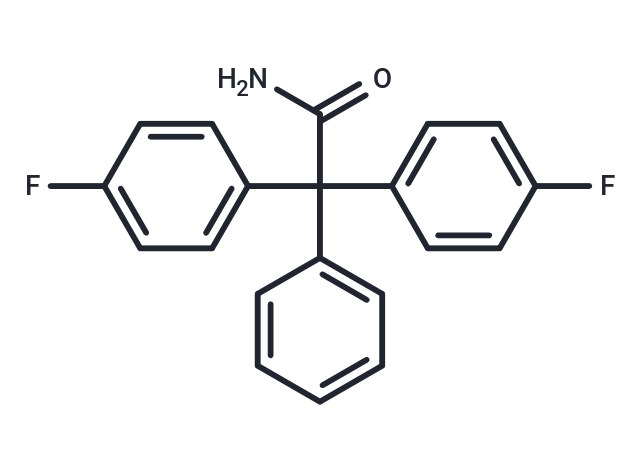Shopping Cart
- Remove All
 Your shopping cart is currently empty
Your shopping cart is currently empty

Senicapoc (ICA-17043) is a potent inhibitor of the Gardos channel that ameliorates RBC dehydration in the SAD mouse. It blocks Ca2+-induced rubidium flux from human RBCs with an IC50 value of 11 ± 2 nM (CLT IC50 = 100 ± 12 nM) and inhibits RBC dehydration with an IC50 of 30 ± 20 nM. Senicapoc is used in the treatment of Sickle Cell Disease and Sickle Cell Anemia.

| Pack Size | Price | Availability | Quantity |
|---|---|---|---|
| 5 mg | $32 | In Stock | |
| 10 mg | $52 | In Stock | |
| 25 mg | $79 | In Stock | |
| 50 mg | $106 | In Stock | |
| 100 mg | $142 | In Stock | |
| 200 mg | $212 | In Stock | |
| 1 mL x 10 mM (in DMSO) | $39 | In Stock |
| Description | Senicapoc (ICA-17043) is a potent inhibitor of the Gardos channel that ameliorates RBC dehydration in the SAD mouse. It blocks Ca2+-induced rubidium flux from human RBCs with an IC50 value of 11 ± 2 nM (CLT IC50 = 100 ± 12 nM) and inhibits RBC dehydration with an IC50 of 30 ± 20 nM. Senicapoc is used in the treatment of Sickle Cell Disease and Sickle Cell Anemia. |
| Targets&IC50 | RBCs (human):11 ± 2 nM, RBC:30 ± 20 nM |
| In vitro | ICA-17043 is shown to block the Gardos channel of mouse (C57 Black) RBCs with an IC50 of 50±6 nM. ICA-17043 blocks this increase in cellular hemoglobin concentration in human RBCs in a concentration-dependent fashion[1]. |
| In vivo | ICA-17043?(10 mg/kg, p.o.) administration produces a significant decrease in Gardos channel activity measured at day 11 and 21 and is associated with a corresponding increase in red cell K+ content without changes in Na+ content. ICA-17043 (10 mg/kg, twice a day) induces a significant increase in Hct after 11 days of dosing in the SAD mouse[1]. Senicapoc (30 mg/kg, p.o.) reduces airway hyperresponsiveness, eosinophil numbers in bronchoalveolar lavage taken 48 hours post-allergen challenge, and vascular remodelling in the sheep[2]. |
| Cell Research | Senicapoc is dissolved in DMSO or 100% ethanol. The whole blood is initially diluted 1:1 with Modified Flux Buffer (MFB), consisting of 140 mM NaCl, 5 mM KCl, 10 mM Tris (tris(hydroxymethyl)aminomethane), 0.1 mM EGTA (ethyleneglycoltetraacetic acid) (pH=7.4). The blood is centrifuged at 1000 rpm, and the pellet comprised primarily of RBCs is washed 3 times with MFB. The cells are then loaded with?86Rb+?by incubating the washed cells with 86Rb+?at a final concentration of 0.185 MBq/mL (5 μCi/mL) in MFB for at least 3 hours at 37°C. After loading with 86Rb+, the RBCs are washed 3 times with chilled MFB. The cells are then incubated for 10 minutes with test compound (senicapoc) at concentrations that ranged from 1 nM to 10?000 nM. Efflux of?86Rb+?is initiated by raising intracellular calcium levels in the RBCs with the addition of CaCl2?and A23187 (a calcium ionophore) to final concentrations of 2 mM and 5 μM, respectively. After 10 minutes of incubation at room temperature, the RBCs are pelleted in a microcentrifuge, and the supernatant is removed and counted in a Wallac MicroBeta liquid scintillation counter. |
| Alias | ICA-17043 |
| Molecular Weight | 323.34 |
| Formula | C20H15F2NO |
| Cas No. | 289656-45-7 |
| Smiles | NC(=O)C(c1ccccc1)(c1ccc(F)cc1)c1ccc(F)cc1 |
| Relative Density. | 1.250 g/cm3 (Predicted) |
| Storage | Powder: -20°C for 3 years | In solvent: -80°C for 1 year | Shipping with blue ice. | |||||||||||||||||||||||||||||||||||
| Solubility Information | DMSO: 50 mg/mL (154.64 mM), Sonication is recommended. | |||||||||||||||||||||||||||||||||||
Solution Preparation Table | ||||||||||||||||||||||||||||||||||||
DMSO
| ||||||||||||||||||||||||||||||||||||

Copyright © 2015-2025 TargetMol Chemicals Inc. All Rights Reserved.